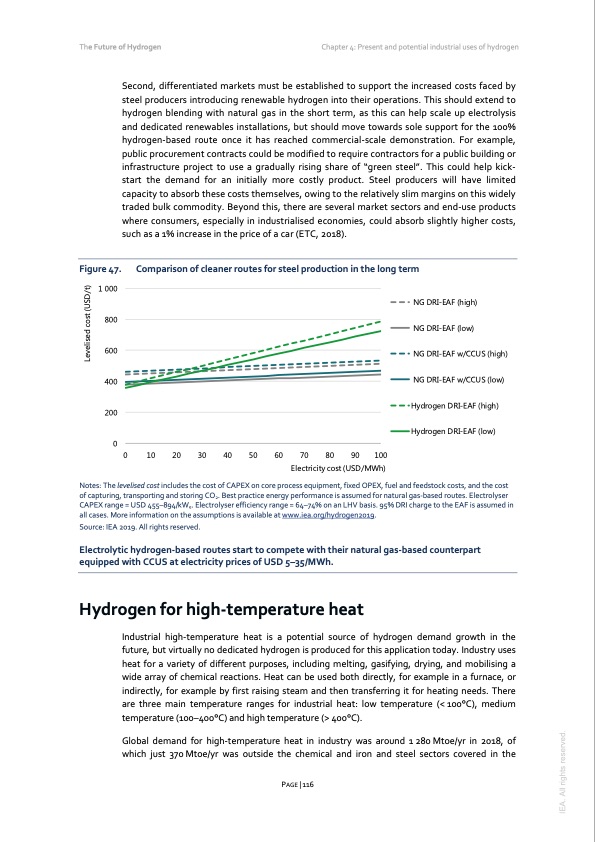
PDF Publication Title:
Text from PDF Page: 116
The Future of Hydrogen Chapter 4: Present and potential industrial uses of hydrogen Figure 47. 1 000 800 600 400 200 0 Second, differentiated markets must be established to support the increased costs faced by steel producers introducing renewable hydrogen into their operations. This should extend to hydrogen blending with natural gas in the short term, as this can help scale up electrolysis and dedicated renewables installations, but should move towards sole support for the 100% hydrogen-based route once it has reached commercial-scale demonstration. For example, public procurement contracts could be modified to require contractors for a public building or infrastructure project to use a gradually rising share of “green steel”. This could help kick- start the demand for an initially more costly product. Steel producers will have limited capacity to absorb these costs themselves, owing to the relatively slim margins on this widely traded bulk commodity. Beyond this, there are several market sectors and end-use products where consumers, especially in industrialised economies, could absorb slightly higher costs, such as a 1% increase in the price of a car (ETC, 2018). Comparison of cleaner routes for steel production in the long term NG DRI-EAF (high) NG DRI-EAF (low) NG DRI-EAF w/CCUS (high) NG DRI-EAF w/CCUS (low) Hydrogen DRI-EAF (high) Hydrogen DRI-EAF (low) 0 10 20 30 40 50 60 70 80 90 100 Electricity cost (USD/MWh) Notes: The levelised cost includes the cost of CAPEX on core process equipment, fixed OPEX, fuel and feedstock costs, and the cost of capturing, transporting and storing CO2. Best practice energy performance is assumed for natural gas-based routes. Electrolyser CAPEX range = USD 455–894/kWe. Electrolyser efficiency range = 64–74% on an LHV basis. 95% DRI charge to the EAF is assumed in all cases. More information on the assumptions is available at www.iea.org/hydrogen2019. Source: IEA 2019. All rights reserved. Electrolytic hydrogen-based routes start to compete with their natural gas-based counterpart equipped with CCUS at electricity prices of USD 5–35/MWh. Hydrogen for high-temperature heat Industrial high-temperature heat is a potential source of hydrogen demand growth in the future, but virtually no dedicated hydrogen is produced for this application today. Industry uses heat for a variety of different purposes, including melting, gasifying, drying, and mobilising a wide array of chemical reactions. Heat can be used both directly, for example in a furnace, or indirectly, for example by first raising steam and then transferring it for heating needs. There are three main temperature ranges for industrial heat: low temperature (< 100°C), medium temperature (100–400°C) and high temperature (> 400°C). Global demand for high-temperature heat in industry was around 1 280 Mtoe/yr in 2018, of which just 370 Mtoe/yr was outside the chemical and iron and steel sectors covered in the PAGE | 116 IEA. All rights reserved. Levelised cost (USD/t)PDF Image | The Future of Hydrogen 2019

PDF Search Title:
The Future of Hydrogen 2019Original File Name Searched:
the_future_of_hydrogen.pdfDIY PDF Search: Google It | Yahoo | Bing
NFT (Non Fungible Token): Buy our tech, design, development or system NFT and become part of our tech NFT network... More Info
IT XR Project Redstone NFT Available for Sale: NFT for high tech turbine design with one part 3D printed counter-rotating energy turbine. Be part of the future with this NFT. Can be bought and sold but only one design NFT exists. Royalties go to the developer (Infinity) to keep enhancing design and applications... More Info
Infinity Turbine IT XR Project Redstone Design: NFT for sale... NFT for high tech turbine design with one part 3D printed counter-rotating energy turbine. Includes all rights to this turbine design, including license for Fluid Handling Block I and II for the turbine assembly and housing. The NFT includes the blueprints (cad/cam), revenue streams, and all future development of the IT XR Project Redstone... More Info
Infinity Turbine ROT Radial Outflow Turbine 24 Design and Worldwide Rights: NFT for sale... NFT for the ROT 24 energy turbine. Be part of the future with this NFT. This design can be bought and sold but only one design NFT exists. You may manufacture the unit, or get the revenues from its sale from Infinity Turbine. Royalties go to the developer (Infinity) to keep enhancing design and applications... More Info
Infinity Supercritical CO2 10 Liter Extractor Design and Worldwide Rights: The Infinity Supercritical 10L CO2 extractor is for botanical oil extraction, which is rich in terpenes and can produce shelf ready full spectrum oil. With over 5 years of development, this industry leader mature extractor machine has been sold since 2015 and is part of many profitable businesses. The process can also be used for electrowinning, e-waste recycling, and lithium battery recycling, gold mining electronic wastes, precious metals. CO2 can also be used in a reverse fuel cell with nafion to make a gas-to-liquids fuel, such as methanol, ethanol and butanol or ethylene. Supercritical CO2 has also been used for treating nafion to make it more effective catalyst. This NFT is for the purchase of worldwide rights which includes the design. More Info
NFT (Non Fungible Token): Buy our tech, design, development or system NFT and become part of our tech NFT network... More Info
Infinity Turbine Products: Special for this month, any plans are $10,000 for complete Cad/Cam blueprints. License is for one build. Try before you buy a production license. May pay by Bitcoin or other Crypto. Products Page... More Info
| CONTACT TEL: 608-238-6001 Email: greg@infinityturbine.com | RSS | AMP |